Etude de bruit de fond induit par les muons dans l'expérience ...
Etude de bruit de fond induit par les muons dans l'expérience ...
Etude de bruit de fond induit par les muons dans l'expérience ...
You also want an ePaper? Increase the reach of your titles
YUMPU automatically turns print PDFs into web optimized ePapers that Google loves.
tel-00724955, version 1 - 23 Aug 2012<br />
2<br />
32 Detecting the WIMP<br />
Figure 2.1: “First light” image of the gamma ray sky from the Fermi Gamma-ray<br />
Space Te<strong>les</strong>cope. Image from [85].<br />
resolution, and an improved anti-coinci<strong>de</strong>nce shield to limit the self-vetoing which<br />
plagued EGRET. Fermi has already released its first image of the gamma ray sky,<br />
see Figure 2.1.<br />
2.2.2 Neutrino <strong>de</strong>tectors<br />
Neutrinos are another leading tracer for WIMP annihilation. Like gamma rays,<br />
neutrinos retain directional and spectral information over cosmological distances.<br />
Their extremely low scattering cross section ren<strong>de</strong>rs them vastly more difficult to<br />
<strong>de</strong>tect, but also allows them to penetrate <strong>de</strong>nse matter. This makes neutrinos i<strong>de</strong>al<br />
probes of WIMP annihilation in the cores of massive objects such as the Sun and<br />
the Earth [69, 70]. Neutrinos are also a possible signature of WIMP annihilation<br />
in the galactic center, but the observable signal is greatly suppressed by the small<br />
solid angle of the Earth as seen from the galactic center.<br />
The SuperKamiokan<strong>de</strong> neutrino <strong>de</strong>tector [86] or the IceCube experiment [87]<br />
can set limits on the rate of WIMP annihilations in the Sun. As <strong>par</strong>tic<strong>les</strong> of dark<br />
matter travel through the solar system, some will elastically scatter insi<strong>de</strong> the Sun.<br />
If they lose enough energy to become gravitationally bound, they will eventually<br />
settle into the center of the Sun, where the WIMP <strong>de</strong>nsity can grow high enough for<br />
annihilations to occur. Among other products, the annihilation can yield neutrinos.<br />
If a high-energy (∼ 1 GeV) muon neutrino reaches the Earth, it may scatter in material<br />
near the surface to produce an energetic muon, that will propagate all the way<br />
through the SuperK chamber, for example. This daughter muon will be emitted in<br />
a direction well-aligned with that of the inci<strong>de</strong>nt neutrino, thus retaining directional<br />
information about the annihilation source. Upward-going <strong>muons</strong> of this sort are easily<br />
distinguished from solar neutrinos by their far greater energies (solar neutrinos<br />
have energies characteristic of nuclear processes: keV-MeV) and from atmospheric<br />
neutrinos by their directional correlation with the Sun’s position in the sky.<br />
When completed, the IceCube experiment will possess a full square kilometer of<br />
effective area and kilometer <strong>de</strong>pth, and will be sensitive to <strong>muons</strong> above approximately<br />
50 GeV [88]. The Deep Core extension of IceCube will be sensitive down<br />
to 10 GeV. The Super-Kamiokan<strong>de</strong> <strong>de</strong>tector, in contrast, has 10 −3 times the effective<br />
area of IceCube and a <strong>de</strong>pth of only 36.2 meters [89]. For low mass WIMPs,


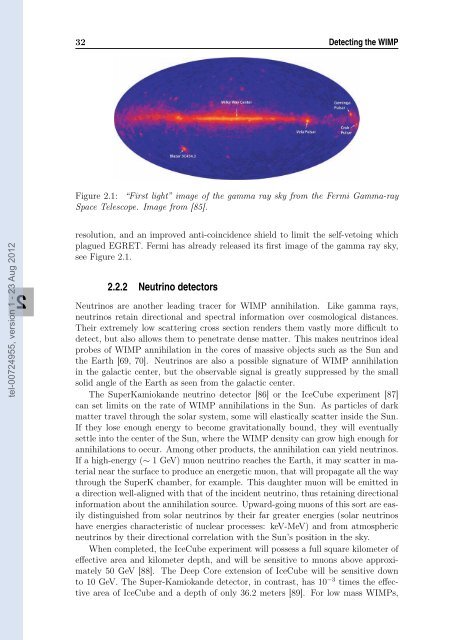

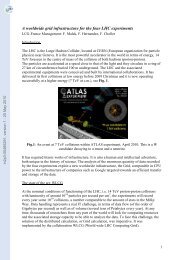

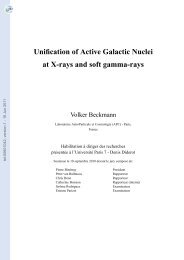

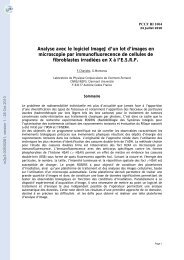
![[in2p3-00383985, v1] NUCLEAR PHYSICS at GANIL ... - HAL - IN2P3](https://img.yumpu.com/19016755/1/185x260/in2p3-00383985-v1-nuclear-physics-at-ganil-hal-in2p3.jpg?quality=85)
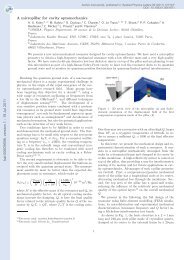
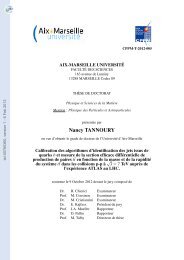
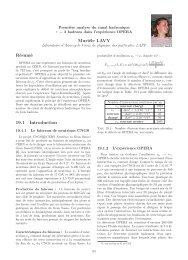
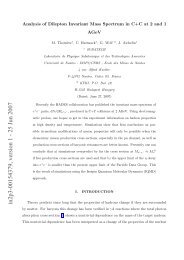
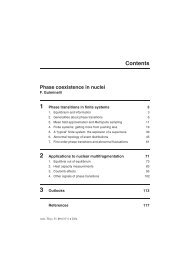
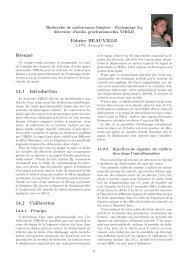
![[tel-00752304, v1] Pions réels et virtuels dans les noyaux](https://img.yumpu.com/19016523/1/184x260/tel-00752304-v1-pions-reels-et-virtuels-dans-les-noyaux.jpg?quality=85)